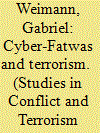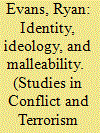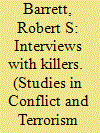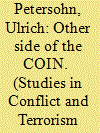|
|
|
Sort Order |
|
|
|
Items / Page
|
|
|
|
|
|
|
| Srl | Item |
| 1 |
ID:
107644


|
|
|
|
|
| Publication |
2011.
|
| Summary/Abstract |
In 1989, the term fatwa became globally known, following Ayatollah Khomeini's death-fatwa issued on Salman Rushdie for his novel, Satanic Verses. Today, the Internet has become a useful platform for posting of fatwas and interpretations of fatwas. The present article highlights the use of jihadist fatwas, and especially online fatwas, as a major instrument in bridging the current wave of terrorism and religion. The analysis, based on a database collected in a 12-year-long project of monitoring thousands of terrorist websites, illustrates how cyber-fatwas are related to key issues in promoting terrorism: justifying the use of suicide terrorism, the killing of innocents, the killing of children and women, the killing of Muslims or the use of various weapons (including weapons of mass destruction and cyberterrorism). There are two implications of the trends documented in this study: First, the analysis of the online fatwas and the fatwa wars may provide insight about the terrorists, their motivations, their doubts and fears and, secondly, it may guide countercampaigns.
|
|
|
|
|
|
|
|
|
|
|
|
|
|
|
|
| 2 |
ID:
107647


|
|
|
|
|
| Publication |
2011.
|
| Summary/Abstract |
Roel Meijer's edited volume fills massive gaps in the Western literature on Salafism, presenting a highly nuanced account of a diverse and internally divided religious identity movement while avoiding the opposing pitfalls of apologetics and polemics. Aside from the diversity of the movement, a key theme throughout the volume is the persistent malleability of Salafi ideology, which has major implications for states, social policy, and international security. The unavoidable conclusion seems to be that even "quietist" strands cannot be considered reliably quietist. Those who seek to better understand the tensions within Salafism, the relationship between this movement and states around the world, and how Salafism stands in relation to various forms of aggressive, violent contention would be well-advised to refer to this volume.
|
|
|
|
|
|
|
|
|
|
|
|
|
|
|
|
| 3 |
ID:
107643


|
|
|
|
|
| Publication |
2011.
|
| Summary/Abstract |
Interviews conducted with leaders, combatants, witnesses, and victims in central Nigeria provide insight into the processes of volunteerism, recruitment, and indoctrination within armed groups. Identified are numerous avenues by which previously nonviolent citizens become willing perpetrators in deadly grass-roots conflict. Despite a commonly advertised motive for joining, narrative analyses reveal several diverse and underlying motivations. Six distinct combatant typologies are described: the Follower, the Pragmatist, the Criminal, the Soldier, the Basic Needs, and the Ideologue. The characteristics of each type, the timing of their entry into the conflict, and the implication for select intervention strategies are discussed.
|
|
|
|
|
|
|
|
|
|
|
|
|
|
|
|
| 4 |
ID:
107646


|
|
|
|
|
| Publication |
2011.
|
| Summary/Abstract |
Why do some terrorist organizations deploy women on the front lines and in violent attacks? This study explores the social conditions, economic factors, and organizational characteristics that might explain women's participation in violent terrorist activity. With a new data set of 395 terrorist organizations, women's participation in terrorist attacks was quantified and coded. The logistic regression analysis results suggest that women's educational attainment, social rights, terrorist organization's age and size, and the level of a country's economic development are important predictors of the deployment of women in terrorist violence while a terrorist group's ideological or religious orientation and the level of democracy do not significantly influence the likelihood of women's participation.
|
|
|
|
|
|
|
|
|
|
|
|
|
|
|
|
| 5 |
ID:
107645


|
|
|
|
|
| Publication |
2011.
|
| Summary/Abstract |
The Iraq War was a watershed regarding the scope of battlefield support by Private Security Companies (PSC). Skeptics soon raised concerns about these new actors being an impediment to the success of the very same operations they are meant to support. According to the critics, PSCs are grist to the mill for insurgents as they employ aggressive tactics and thereby alienate the population, cause credibility problems because they enjoy impunity, and increase coordination problems since they are not subordinated under the military chain of command. This article argues that this is not a necessary result of their employment, but rather the consequence of a lack of preparedness to operate alongside PSCs. However, the military is accustomed to adapting to new unexpected circumstances. Hence, when problems occurred, the armed forces underwent a trial and error learning process that improved PSC employment. The empirical picture supports this view. Initially, the counterinsurgency effort did indeed suffer from the actions, lack of oversight, and lack of coordination of PSCs. However, over the course of the Iraq War, most of the shortfalls were either improved significantly or even resolved.
|
|
|
|
|
|
|
|
|
|
|
|
|
|
|
|
|
|
|
|
|